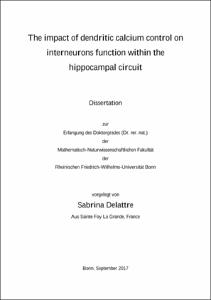The impact of dendritic calcium control on interneurons function within the hippocampal circuit

The impact of dendritic calcium control on interneurons function within the hippocampal circuit

| dc.contributor.advisor | Dietrich, Dirk | |
| dc.contributor.author | Delattre, Sabrina | |
| dc.date.accessioned | 2020-04-24T23:10:09Z | |
| dc.date.available | 2020-04-24T23:10:09Z | |
| dc.date.issued | 11.05.2018 | |
| dc.identifier.uri | https://hdl.handle.net/20.500.11811/7494 | |
| dc.description.abstract | In the past few decades, dendritic integration has been extensively studied in hippocampal excitatory cells (for review see Stuart and Spruston 2015). However, much less effort has been put into understanding inhibitory neurons input integration since they are so diversified and are mostly aspiny (Klausberger and Somogyi 2008). In this thesis we sought to contribute to the understanding of input integration in interneurons by studying calcium signaling in three different morphologically defined interneuron subtypes. As calcium is one of the most prominent second messengers in the brain, we postulated that it can contribute to the input integration and thus to the output response of interneurons, leading to a specific control of pyramidal cells output. Calcium amplitude, duration and location trigger the direction of plasticity (Evans and Blackwell 2015). A high amplitude and fast calcium entry will most likely trigger LTP; while long lasting and low amplitude calcium, should trigger LTD (Evans and Blackwell 2015). As a mechanism controlling calcium diffusion and free calcium concentration, endogenous buffer is a key component for neurons to regulate intracellular calcium signal. Indeed, depending on the buffer identity and the buffering fraction, free calcium will be rapidly or slowly bound which could influence the direction of the plasticity given the same input within a cell type. CCK positive basket cells, PV positive basket cells and PV negative dendritic targeting cells were chosen according to their specific pyramidal somatic/dendritic target and their distinct involvement in hippocampal oscillations. To resolve the importance of calcium signaling regulation on those interneurons’ function, we directed our study from calcium signaling biophysical determination to more physiological relevance within network activity. Biophysical determination including calcium entry, endogenous buffering capacity and diffusion environment of calcium signaling in CCKBC, PVBC and D-T cells were found to be unique in each interneuron subtype. As a consequence, this sole mechanism of calcium signal regulation points to different dendritic input integration and may lead to different calcium dependent plasticity mechanisms for each interneuron subtype. Therefore, we investigated the backpropagation of action potential induced calcium transient (bAP-CaT) in CCKBC, PVBC and D-T cells. We discovered a similar medial limit to bAP-CaT in CCKBC and PVBC; however D-T cells showed a stable distal bAP-CaT. bAP-CaT is not modulated by mobile and fixed endogenous buffering capacity in PVBC and D-T cells, but the fixed buffering fraction of CCKBC does influence its bAP-CaT. This finding indeed shows the importance of calcium buffering in shaping calcium entry and so controlling the input integration in a cell-dependent manner. Finally, upon network activity, interneurons are differently recruited (Klausberger and Somogyi 2008). We investigated CCKBC electrophysiology and calcium signaling during network activity via cholinergic activation. CCKBC experience a drastic change in intrinsic excitability, a small change in their resting calcium concentration and a larger amplitude calcium entry during cholinergic network activation. These changes may happen because of an increase in intrinsic excitability mediated by a reduction of SK current upon M1 and M3r activation as for OLM interneurons (Bell, Bell et al. 2015) In conclusion, calcium signaling handling appears unique for the 3 interneurons subtypes studied, which might confirm their differential recruitment and output seen during hippocampal rhythmogenesis. This study is the first step toward understanding the importance of calcium signaling in synaptic and somatic input integration in interneurons. | |
| dc.language.iso | eng | |
| dc.rights | In Copyright | |
| dc.rights.uri | http://rightsstatements.org/vocab/InC/1.0/ | |
| dc.subject | interneurons | |
| dc.subject | calcium signaling | |
| dc.subject | hippocampus | |
| dc.subject | endogenous buffer | |
| dc.subject.ddc | 570 Biowissenschaften, Biologie | |
| dc.subject.ddc | 610 Medizin, Gesundheit | |
| dc.title | The impact of dendritic calcium control on interneurons function within the hippocampal circuit | |
| dc.type | Dissertation oder Habilitation | |
| dc.publisher.name | Universitäts- und Landesbibliothek Bonn | |
| dc.publisher.location | Bonn | |
| dc.rights.accessRights | openAccess | |
| dc.identifier.urn | https://nbn-resolving.org/urn:nbn:de:hbz:5n-49654 | |
| ulbbn.pubtype | Erstveröffentlichung | |
| ulbbnediss.affiliation.name | Rheinische Friedrich-Wilhelms-Universität Bonn | |
| ulbbnediss.affiliation.location | Bonn | |
| ulbbnediss.thesis.level | Dissertation | |
| ulbbnediss.dissID | 4965 | |
| ulbbnediss.date.accepted | 11.01.2018 | |
| ulbbnediss.institute | Medizinische Fakultät / Kliniken : Klinik und Poliklinik für Neurochirurgie | |
| ulbbnediss.fakultaet | Mathematisch-Naturwissenschaftliche Fakultät | |
| dc.contributor.coReferee | Witke, Walter |
Dateien zu dieser Ressource
Das Dokument erscheint in:
-
E-Dissertationen (4118)




